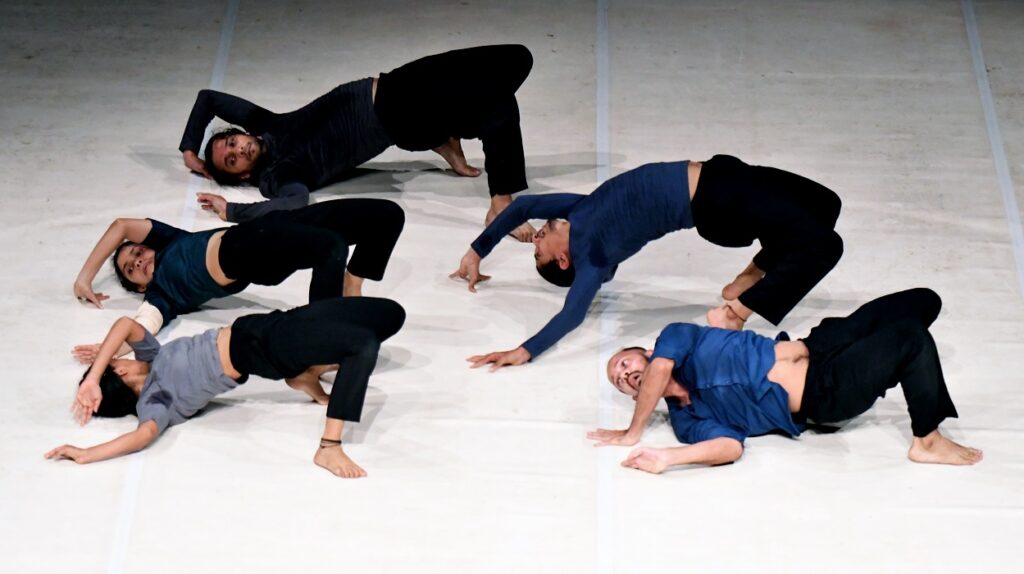A review on Priyabrat Panigrahi’s How Long is Forever
A review on Priyabrat Panigrahi’s How Long is Forever?
by Rohee Uberoi
How Long is Forever?, choreographed by Priyabrat Panigrahi was the first production to start off Platform 22, a curation of original ensemble work by upcoming as well as established choreographers at Attakkalari India Biennial, 2021-22.
This 50 minute long piece presents five bodies in space performing movements that involve choreographic devices such as canon, repetition, weight sharing and contact improvisation to arrive at a heightened sense of connection across them. At no point do any of the five dancers leave the stage. They move, they pause, almost always together. A playful rhythm that they together set, brings the audience to experience time and its velocity. Time that accelerates and decelerates in the form of moving/dancing bodies. The work foregrounds a study of temporality through varied processes and series of embodiment.

PC: Samuel Rajkumar, Attakkalari India Biennial 2021-22
I had the chance to see the work both while it was being performed in a studio setting, and when it was showcased at Rangashankara with stage lights and a white floor. Wherein one would watch it from a distance but also in all its intricacies and vivid details only further heightened by the context of the proscenium. In the studio, the bodies had somehow seemed flawless despite being watched from an intimate distance. But within the amphitheatrical setting of Rangashankara, the dancing bodies were now exposed to deeper scrutiny as it were. From such a distance and in such an expansive space, one got to see the smallest of the shifts that the performing bodies underwent. In the studio, the bodies were moving more across the width of the space. However, in the amphitheatre, they moved more back and forth, emphasising the depth that the stage offered for them. I got to notice the choreographic choices that were made keeping in mind the specificities of each of the two spaces. In the studio, I got to see how the bodies supported each other, listened and responded as well as shared roles and responsibilities while finding a singular breath as an organism. All of which only became further more performative and almost virtuosic when the stage lights got added as an important layer into the composition of the work.
The soundscape and the movement jargon kept amplifying and found an overall rhythmic unison and concordance even in moments of sonorous silence. The industrial, almost static tones, the melodies and the looping tempos, well punctuated with the walking, running, sliding and rolling, lifting, jumps and falls, staccato and flow, tension and release that the dancing bodies performed. It seemed to me that the soundscape was inviting them to contribute to its groove, while also giving them the space to harmonize themselves with it.

PC: Samuel Rajkumar, Attakkalari India Biennial 2021-22
The circularity and tangents in the dancers’ orientation (especially when illuminated by the lights) along with repetition and rest as a part of their movement score gave me a sense of a ritual. As though the visuals and music were setting a stance for some kind of a ceremonial celebration. The way in which the dancers exchanged glances amongst themselves and with the audience, it seemed as if the movement in their eyes was enough to generate a dual sense of expansion and contraction. I saw the relationship between the dancers and the spatial elements evolving in the form of crests and troughs of energy as well as traces of something about to burst only to be contained thereafter. The dancers would gravitate towards and away from each other, into and away from darkness, which created an illusion of a spatial manipulation, as though the space was pulling and throwing them, taking care of them and yet again putting them at risk.
While the dancers found comfort in virtuosity, every viewing of the performance transformed my relationship with this athleticism- it moved from being fascinating, intimidating, redundant, to something that resonated with me. Every leap of faith, fall of trust, entering and receding started to seem like a play of discovery and sweet discomfort. I saw grandiose but also vulnerability. I also saw moments that spelled out errors in judgment and decision making. I saw trickling sweat on the skin, the fabric and the walls, breathlessness and recovery, asymmetry, exhaustion, tiredness, effortfulness, force, all of which came together to only further humanise these dancing bodies way beyond their performative calibre and stage presence.

PC: Samuel Rajkumar, Attakkalari India Biennial 2021-22
To suggest transitions from one section into the other, the dancers oriented themselves in different ways, paused, leaned on to each other, stood or sat, allowing for the viewer a breathing space, but also a space for reflecting on the images that one just finished watching. This led me to ponder upon how the idea of rest was important to the piece. I wondered if beyond suggesting physical recovery and shifts between quality and energy, this motif was also challenging the notion of stillness (as we are always moving, through circulatory systems within ourselves and minute calibrations/ adjustments within the body). After a point, I started to grasp this as a pattern in the piece, which also then generated a sense of anchoring for me. These pauses that I could only read as references to simplicity and familiarity sat well with the overall pacing and dynamism of the piece, gradually turning into its most characteristic element. The stagecraft and attire was at its minimum, yet this play of rest and motion infused life into the space. How long is forever? was a performance of negotiation with Time, which it very well succeeded at before it receded into darkness or a sort of oblivion.






Bentonfef
August 30, 2022great post to read
indian ipl betting sites